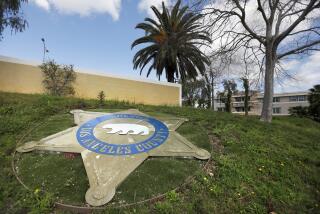Researchers, activists urge faster pace in effort to save Lake Tahoe
The effort to restore Lake Tahoe, which has cost $1.1 billion over the last decade, must accelerate dramatically if it is to cope with newly documented effects of global warming, researchers and environmental advocates said this week.
A report by UC Davis scientists found that conditions at the nation’s second-deepest lake have changed significantly in recent years. The 45-page report -- a summary of tens of thousands of observations of water conditions and aquatic life collected since the 1960s, along with a century of meteorological data -- shows that days and nights are warmer, rain is replacing snow, and lake water temperatures are rising, setting a record in July 2006 of 78 degrees. Invasive species are multiplying.
“The lake’s ecosystem is at a point where it is changing rapidly,” said Geoff Schladow, director of the UC Davis Tahoe Environmental Research Center. “We can’t stop climate change, but we can account for it. Business as usual won’t bring us to where we need to be.”
In the last decade, the environmental restoration was focused on regaining Tahoe’s dazzling clarity, which had declined from an average depth of 102 feet to a low of 64 feet in 1997. A coalition of state, local, federal and private agencies has restored wetlands, reconstructed roads, built storm drainage systems, restricted building and encouraged public transportation in an effort to stem the erosion and pollution that dirtied the lake’s cobalt-blue water.
But UC Davis’ “Tahoe: State of the Lake Report 2007” takes a broader view of the region’s problems -- documenting the manifold effects of global warming, which threaten to wipe out much of the progress of the last decade. Last year, Tahoe’s clarity declined by 4.6 feet, to an average depth of 67.7 feet. The backsliding was due to a rainy year, which washed more sediment than usual into the lake.
But the increase in rain is no accident. In 1911, more than half of the region’s precipitation was in the form of snow. Today it is only 34% -- the result of warmer temperatures. Last year, more than 48 inches of rain fell around the lake -- an 84% increase over the annual average from 2001 to 2005.
The dearth of snow has been a major concern for the area’s ski industry, just as the turbidity of the lake water is a factor in summer tourism.
Days and nights in the Tahoe region are warmer. Days with temperatures below freezing have declined from 79 in 1911 to 52 now. Night temperatures have risen more than 4 degrees in the same period.
“Climate change poses a new kind of threat to Lake Tahoe,” said Rochelle Nason, executive director of the nonprofit League to Save Lake Tahoe.
Nason estimated it would cost between $2 billion and $3 billion over the next decade to stabilize the lake.
More than 1,000 acres of wetlands should be restored to serve as a filter for sediment and pollutants before they wash into the lake, Nason said. Of the 1,400 parcels of land around the lake that remain undeveloped, as many as possible should be purchased and conserved as open space, she added.
Schladow, the study’s lead author, said urgent measures should be taken to eradicate invasive species such as the Eurasian water milfoil, a plant that roots in the lake’s shallows and can grow 4 feet tall, as well as such warm-water fish as carp and bass that are gobbling up native trout.
As yet, the nonnative species are growing in marinas, but “in five years, they could be all over the lake,” Schladow said. “If we don’t act soon, the task will be much more expensive.”
--
More to Read
Start your day right
Sign up for Essential California for news, features and recommendations from the L.A. Times and beyond in your inbox six days a week.
You may occasionally receive promotional content from the Los Angeles Times.







